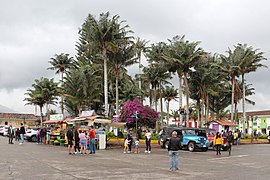Salento, Quindío
Salento | |
|---|---|
Municipality and town | |
 | |
|
UTC-5 (GMT-5) | |
| Website | http://www.salento-quindio.gov.co |
Salento is a town and
The main route from
History
In the colonial era, the main route from
The site of the penal colony was known as Barcinales, located where Salento is today. However, the main settlement was in the valley in Boquía, where the Boquía stream joins the Quindío river. Families of the prisoners arrived and built their houses in Boquía and established farms upstream in the Cocora valley.
Sometime around 1854 a flood of the Quindío river destroyed the settlement of Boquía, and the survivors rebuilt their houses in Barcinales. They retained the name Boquía for the new settlement, changing the name of the original settlement to Pueblo Viejo.
In 1864 a census of the new Boquía showed that it had 581 inhabitants. The occupational breakdown comprised 148 farmers, 2 carpenters, 1 blacksmith, 11 doctors, 1 lawyer, 2 tailors, 4 laborers, 11 merchants and 11 watchmakers.
In 1865 Boquía was officially declared a municipality and its name was changed again to Villa de Nueva Salento, and the name of Boquía reverted to the original settlement in the valley. The new name of the municipality was given in honor of Salento, a region in the south of Italy.
Geography
The municipality of Salento is located in the north-eastern corner of the department of Quindío. It borders the municipalities of
The town of Salento itself lies on a plateau above the
Climate
Due to its altitude and proximity to the high mountains of the
Tourist attractions
The town is one of the major tourist attractions of Colombia, thanks to its peaceful nature (although it fills up with tourists at weekends and on bank holidays), impressive scenery, easy access to the Cocora valley, and the retention of much of its original bahareque architecture typical of the eje cafetero region. This style of architecture is especially notable on Carrera 6, a.k.a. Calle Real (English: Royal Road), the road that leads north-east from the town square to a mirador (look-out point), the Alto de la Cruz. The road is the major thoroughfare of Salento and contains many shops, mainly selling locally-made handcrafts.
The Alto de la Cruz is reached from the end of Calle Real via 250 steps marked with the fourteen Stations of the Cross spaced at intervals along the way. An alternative, less direct route to the mirador by road avoids the steps. From the mirador there are extensive views of the Cocora valley and many of the mountains of the Los Nevados National Natural Park.
The restaurants, particularly those in the town square, specialize in freshwater
Salento is the starting point for excursions into the Cocora valley and hiking in the Los Nevados National Natural Park: jeep taxis leave from the town square and travel 11 km up the valley to the settlement of "Cocora", from where the valley may be explored on foot or on horseback via numerous trails.
The town's festival takes place each year in the first week of January, to coincide with the celebrations of the anniversary of the town's foundation on 5 January.
-
Plaza de Bolívar
-
Calle Real
-
Church of Nuestra Señora del Carmen
-
Street of Salento
Economy
Tourism is the dominant economy of the town, but outside the urban area farming and agriculture is still important, with dairy farming and the production of coffee and flowers among other crops.
See also
References
- ^ Telefónicas, Telencuestas-Encuestas. "Cuántos habitantes tiene Salento, Quindío en 2023". Telencuestas (in Spanish). Retrieved 2023-09-27.
- ^ a b Salento municipality website
- ^ Telefónicas, Telencuestas-Encuestas. "Cuántos habitantes tiene Salento, Quindío en 2023". Telencuestas (in Spanish). Retrieved 2023-09-27.
- ^ "Coffee Cultural Landscape". UNESCO World Heritage List. United Nations Educational, Scientific, and Cultural Organization. Retrieved 25 Apr 2011.
- ^ "SALENTO - Gobernación del Quindio". quindio.gov.co (in European Spanish). Retrieved 2023-09-27.
- Loaiza Piedrahita, Oscar (2004), Los corredores del tiempo: Guía turística por la historia del Quindío. ISBN 958-33-7088-6. Book in Spanish on the history of the municipalities of Quindío until the foundation of the department in 1966. The local history is placed in the context of wider events in Colombia.
External links
 Salento travel guide from Wikivoyage
Salento travel guide from Wikivoyage- Official website of Salento municipality (in Spanish)






